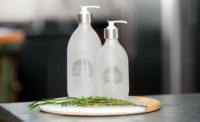Has Amazon Hijacked Your Customer’s Brand Experience?
In the new world of e-commerce and the 24-to-48-hour delivery model, you can either let Amazon come up with a packaging and delivery solution or you can take back control of the end-to-end experience.

Photo Credit: Julie Clopper / iStock Editorial / Getty Images
It takes years to develop, design and manufacture a skincare product. The package design consists of a carefully constructed bottle with soft lines that cue the product benefits complemented by gorgeous graphics to support the brand promise. On the retail shelf it sits poised to catch the attention of consumers. But, what if that same consumer buys it online? She waits with anticipation until the familiar brown truck pulls up. She then watches the delivery person flip the package off the truck, which lands with a thud on the concrete steps as she opens the door. The opened package reveals a leaking mess because the bottle was either not secured properly or it was packed with other items to keep shipping costs down. In that instant the brand promise is broken, and the consumer will likely decide that this will be the last time she orders the product.
According to a survey by Sealed Air Corporation, 58 percent of Americans say that if they receive a damaged or broken product from an online order they would either consider purchasing from a competitor or would not purchase from that retailer again. While retail packaging’s focus is on brand recognition and standing out on the shelf, e-commerce packaging is all about customer experience. The e-com package needs to be designed to withstand direct shipment while creating a memorable experience for consumers. We can control the brand experience in the retail environment with protective shippers and well-lit shelves lined with product, but how can we protect goods while offering surprise and delight in the e-commerce world? Even venerable brands such as Method are facing the same dilemma. As with any liquid product merchandised in a pump bottle, e-commerce retailers will find their own solution to prevent leakage/spillage. Heavy-duty tape around the neck and pump may do the trick, but it also completely destroys the brand image and gives the consumer another headache when trying to remove the layers of tape—and it leaves a sticky residue once the extra task is completed. Compare that to the rows of beautifully shaped jewel-toned soap dispensers a consumer sees on shelf.
Turn problems into opportunities
This perceived problem is actually an opportunity for brands to regain control. Smart design solutions can reduce materials, lower costs and create features that excite consumers. By taking a holistic approach to design and a new look at materials, brands won’t be at the mercy of online retailers. One way to do this successfully is to conduct an analysis of the full lifecycle of a package from manufacture to consumer usage. Why? Because if you try to solve for one problem you may compromise another—and you’ll be stuck in an endless loop of fixes. In order to create an ideal consumer experience while solving the technical challenges, an analysis must include technical and shipping constraints and maintain product margins while delivering a pleasant consumer experience. Here’s how to do it:
Make a good first impression
Consider the first place a consumer will see your brand. In the retail environment that would be on the shelf, but in the e-commerce world it could be a tiny one-inch image that must be able to tell the product story, capture consumers’ attention and entice them to click for more details (additional views). If a front-view image of your product is shown, then that image alone must convey your brand’s attributes. That may mean the package shape is designed to instantly communicate the soft, silky feel of a skincare cream.
Create an experience
The popularity of unboxing videos on YouTube indicates that e-commerce consumers think of opening packages as the unveiling of a gift to themselves. We can’t emphasize enough the value of this unboxing experience, and brands must ensure that they can consistently deliver. So while shampoo bottles may look lovely on a retail shelf, their tendency to roll around the inside of a box requires a different approach. Rather than blindly allowing packers in a warehouse to stuff plastic pillows and tape the closures, brands can take control by designing with a flat back—allowing them to naturally be presented face up and proudly display the product the way the brand intended it to be. This same package works both on shelf and for e-commerce. When packaging is designed with this in mind, products don’t have to be shipped with excessive packaging materials such as air pillows, corrugated paper or Styrofoam; instead it can be sent in a smaller box which saves money and helps the environment.
Encourage engagement
Whether it be love, satisfaction, curiosity or even anger, the overall experience evokes powerful emotions about the brand and spurs action. Consumers’ rate and review products, post opinions on social media, tell friends and buy more product. Ideally, total brand engagement is experienced by sharing an experience with friends, family and—quite possibly—the entire world.
Delivering an e-commerce experience that drives rave reviews and positive word of mouth is about getting everything right at the same time: products are delivered at the right price, arrive in the right condition and provide the right user experience. This is how we take back control.
Looking for a reprint of this article?
From high-res PDFs to custom plaques, order your copy today!





